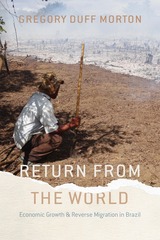23 books about Cultural Change
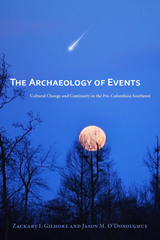
The Archaeology of Events
Cultural Change and Continuity in the Pre-Columbian Southeast
Zackary I. Gilmore and Jason M. O'Donoughue
University of Alabama Press, 2015
The first work to apply an events-based approach to the analysis of pivotal developments in the pre-Columbian Southeast
Across the social sciences, gradualist evolutionary models of historical dynamics are giving way to explanations focused on the punctuated and contingent “events” through which history is actually experienced. The Archaeology of Events is the first book-length work that systematically applies this new eventful approach to major developments in the pre-Columbian Southeast.
Traditional accounts of pre-Columbian societies often portray them as “cold” and unchanging for centuries or millennia. Events-based analyses have opened up archaeological discourse to the more nuanced and flexible idea of context-specific, rapidly transpiring, and broadly consequential historical “events” as catalysts of cultural change.
The Archaeology of Events, edited by Zackary I. Gilmore and Jason M. O’Donoughue, considers a variety of perspectives on the nature and scale of events and their role in historical change. These perspectives are applied to a broad range of archeological contexts stretching across the Southeast and spanning more than 7,000 years of the region’s pre-Columbian history. New data suggest that several of this region’s most pivotal historical developments, such as the founding of Cahokia, the transformation of Moundville from urban center to vacated necropolis, and the construction of Poverty Point’s Mound A, were not protracted incremental processes, but rather watershed moments that significantly altered the long-term trajectories of indigenous Southeastern societies.
In addition to exceptional occurrences that impacted entire communities or peoples, southeastern archaeologists are increasingly recognizing the historical importance of localized, everyday events, such as building a house, crafting a pot, or depositing shell. The essays collected by Gilmore and O’Donoughue show that small-scale events can make significant contributions to the unfolding of broad, regional-scale historical processes and to the reproduction or transformation of social structures.
The Archaeology of Events is the first volume to explore the archaeological record of events in the Southeastern United States, the methodologies that archaeologists bring to bear on this kind of research, and considerations of the event as an important theoretical concept.
Across the social sciences, gradualist evolutionary models of historical dynamics are giving way to explanations focused on the punctuated and contingent “events” through which history is actually experienced. The Archaeology of Events is the first book-length work that systematically applies this new eventful approach to major developments in the pre-Columbian Southeast.
Traditional accounts of pre-Columbian societies often portray them as “cold” and unchanging for centuries or millennia. Events-based analyses have opened up archaeological discourse to the more nuanced and flexible idea of context-specific, rapidly transpiring, and broadly consequential historical “events” as catalysts of cultural change.
The Archaeology of Events, edited by Zackary I. Gilmore and Jason M. O’Donoughue, considers a variety of perspectives on the nature and scale of events and their role in historical change. These perspectives are applied to a broad range of archeological contexts stretching across the Southeast and spanning more than 7,000 years of the region’s pre-Columbian history. New data suggest that several of this region’s most pivotal historical developments, such as the founding of Cahokia, the transformation of Moundville from urban center to vacated necropolis, and the construction of Poverty Point’s Mound A, were not protracted incremental processes, but rather watershed moments that significantly altered the long-term trajectories of indigenous Southeastern societies.
In addition to exceptional occurrences that impacted entire communities or peoples, southeastern archaeologists are increasingly recognizing the historical importance of localized, everyday events, such as building a house, crafting a pot, or depositing shell. The essays collected by Gilmore and O’Donoughue show that small-scale events can make significant contributions to the unfolding of broad, regional-scale historical processes and to the reproduction or transformation of social structures.
The Archaeology of Events is the first volume to explore the archaeological record of events in the Southeastern United States, the methodologies that archaeologists bring to bear on this kind of research, and considerations of the event as an important theoretical concept.
[more]
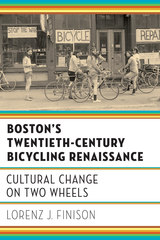
Boston's Twentieth-Century Bicycling Renaissance
Cultural Change on Two Wheels
Lorenz J. Finison
University of Massachusetts Press, 2019
At the end of the nineteenth century, cycling's popularity surged in the Boston area, but by 1900, the trend faded. Within the next few decades, automobiles became commonplace and roads were refashioned to serve them. Lorenz J. Finison argues that bicycling witnessed a renaissance in the 1970s as concerns over physical and environmental health coalesced. Whether cyclists hit the roads on their way to work or to work out, went off-road in the mountains or to race via cyclocross and BMX, or took part in charity rides, biking was back in a major way.
Finison traces the city's cycling history, chronicling the activities of environmental and social justice activists, stories of women breaking into male-dominated professions by becoming bike messengers and mechanics, and challenges faced by African American cyclists. Making use of newspaper archives, newly discovered records of local biking organizations, and interviews with Boston-area bicyclists and bike builders, Boston's Twentieth-Century Bicycling Renaissance brings these voices and battles back to life.
Finison traces the city's cycling history, chronicling the activities of environmental and social justice activists, stories of women breaking into male-dominated professions by becoming bike messengers and mechanics, and challenges faced by African American cyclists. Making use of newspaper archives, newly discovered records of local biking organizations, and interviews with Boston-area bicyclists and bike builders, Boston's Twentieth-Century Bicycling Renaissance brings these voices and battles back to life.
[more]
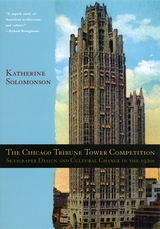
The Chicago Tribune Tower Competition
Skyscraper Design and Cultural Change in the 1920s
Katherine Solomonson
University of Chicago Press, 2003
In 1922, the Chicago Tribune sponsored an international competition to design its new corporate headquarters. Both a serious design contest and a brilliant publicity stunt, the competition received worldwide attention for the hundreds of submissions—from the sublime to the ridiculous—it garnered.
In this lavishly illustrated book, Katherine Solomonson tells the fascinating story of the competition, the diverse architectural designs it attracted, and its lasting impact. She shows how the Tribune used the competition to position itself as a civic institution whose new headquarters would serve as a defining public monument for Chicago. For architects, planners, and others, the competition sparked influential debates over the design and social functions of skyscrapers. It also played a crucial role in the development of advertising, consumer culture, and a new national identity in the turbulent years after World War I.
In this lavishly illustrated book, Katherine Solomonson tells the fascinating story of the competition, the diverse architectural designs it attracted, and its lasting impact. She shows how the Tribune used the competition to position itself as a civic institution whose new headquarters would serve as a defining public monument for Chicago. For architects, planners, and others, the competition sparked influential debates over the design and social functions of skyscrapers. It also played a crucial role in the development of advertising, consumer culture, and a new national identity in the turbulent years after World War I.
[more]

Chinese Migrant Networks and Cultural Change
Peru, Chicago, and Hawaii 1900-1936
Adam McKeown
University of Chicago Press, 2001
Inspired by recent work on diaspora and cultural globalization, Adam McKeown asks in this new book: How were the experiences of different migrant communities and hometowns in China linked together through common networks? Chinese Migrant Networks and Cultural Change argues that the political and economic activities of Chinese migrants can best be understood by taking into account their links to each other and China through a transnational perspective. Despite their very different histories, Chinese migrant families, businesses, and villages were connected through elaborate networks and shared institutions that stretched across oceans and entire continents. Through small towns in Qing and Republican China, thriving enclaves of businesses in South Chicago, broad-based associations of merchants and traders in Peru, and an auspicious legacy of ancestors in Hawaii, migrant Chinese formed an extensive system that made cultural and commercial exchange possible.
[more]
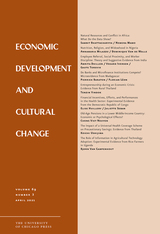
Economic Development and Cultural Change, volume 69 number 3 (April 2021)
The University of Chicago Press
University of Chicago Press Journals, 2021

Economic Development and Cultural Change, volume 69 number 4 (July 2021)
The University of Chicago Press
University of Chicago Press Journals, 2021

Economic Development and Cultural Change, volume 70 number 1 (October 2021)
The University of Chicago Press
University of Chicago Press Journals, 2021

Economic Development and Cultural Change, volume 70 number 2 (January 2022)
The University of Chicago Press
University of Chicago Press Journals, 2022

Economic Development and Cultural Change, volume 70 number 3 (April 2022)
The University of Chicago Press
University of Chicago Press Journals, 2022

Economic Development and Cultural Change, volume 70 number 4 (July 2022)
The University of Chicago Press
University of Chicago Press Journals, 2022

Economic Development and Cultural Change, volume 71 number 1 (October 2022)
The University of Chicago Press
University of Chicago Press Journals, 2022
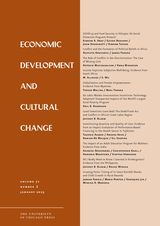
Economic Development and Cultural Change, volume 71 number 2 (January 2023)
The University of Chicago Press
University of Chicago Press Journals, 2023
This is volume 71 issue 2 of Economic Development and Cultural Change. Economic Development and Cultural Change (EDCC) publishes studies that use modern theoretical and empirical approaches to examine both the determinants and the effects of various dimensions of economic development and cultural change. EDCC’s focus is on empirical papers with analytic underpinnings, concentrating on microlevel evidence, that use appropriate data to test theoretical models and explore policy impacts related to economic development.
[more]
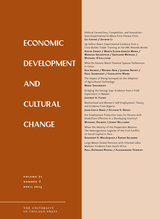
Economic Development and Cultural Change, volume 71 number 3 (April 2023)
The University of Chicago Press
University of Chicago Press Journals, 2023
This is volume 71 issue 3 of Economic Development and Cultural Change. Economic Development and Cultural Change (EDCC) publishes studies that use modern theoretical and empirical approaches to examine both the determinants and the effects of various dimensions of economic development and cultural change. EDCC’s focus is on empirical papers with analytic underpinnings, concentrating on microlevel evidence, that use appropriate data to test theoretical models and explore policy impacts related to economic development.
[more]
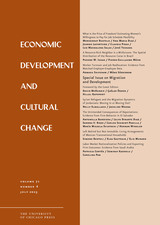
Economic Development and Cultural Change, volume 71 number 4 (July 2023)
The University of Chicago Press
University of Chicago Press Journals, 2023
This is volume 71 issue 4 of Economic Development and Cultural Change. Economic Development and Cultural Change (EDCC) publishes studies that use modern theoretical and empirical approaches to examine both the determinants and the effects of various dimensions of economic development and cultural change. EDCC’s focus is on empirical papers with analytic underpinnings, concentrating on microlevel evidence, that use appropriate data to test theoretical models and explore policy impacts related to economic development.
[more]

Economic Development and Cultural Change, volume 72 number 1 (October 2023)
The University of Chicago Press
University of Chicago Press Journals, 2023
This is volume 72 issue 1 of Economic Development and Cultural Change. Economic Development and Cultural Change (EDCC) publishes studies that use modern theoretical and empirical approaches to examine both the determinants and the effects of various dimensions of economic development and cultural change. EDCC’s focus is on empirical papers with analytic underpinnings, concentrating on microlevel evidence, that use appropriate data to test theoretical models and explore policy impacts related to economic development.
[more]
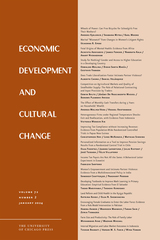
Economic Development and Cultural Change, volume 72 number 2 (January 2024)
The University of Chicago Press
University of Chicago Press Journals, 2024
This is volume 72 issue 2 of Economic Development and Cultural Change. Economic Development and Cultural Change (EDCC) publishes studies that use modern theoretical and empirical approaches to examine both the determinants and the effects of various dimensions of economic development and cultural change. EDCC’s focus is on empirical papers with analytic underpinnings, concentrating on microlevel evidence, that use appropriate data to test theoretical models and explore policy impacts related to economic development.
[more]

Economic Development and Cultural Change, volume 72 number 3 (April 2024)
The University of Chicago Press
University of Chicago Press Journals, 2024
This is volume 72 issue 3 of Economic Development and Cultural Change. Economic Development and Cultural Change (EDCC) publishes studies that use modern theoretical and empirical approaches to examine both the determinants and the effects of various dimensions of economic development and cultural change. EDCC’s focus is on empirical papers with analytic underpinnings, concentrating on microlevel evidence, that use appropriate data to test theoretical models and explore policy impacts related to economic development.
[more]

Economic Development and Cultural Change, volume 72 number 4 (July 2024)
The University of Chicago Press
University of Chicago Press Journals, 2024
This is volume 72 issue 4 of Economic Development and Cultural Change. Economic Development and Cultural Change (EDCC) publishes studies that use modern theoretical and empirical approaches to examine both the determinants and the effects of various dimensions of economic development and cultural change. EDCC’s focus is on empirical papers with analytic underpinnings, concentrating on microlevel evidence, that use appropriate data to test theoretical models and explore policy impacts related to economic development.
[more]

Gardens and Cultural Change
A Pan-American Perspective
Michel Conan
Harvard University Press, 2007
Gardens contain time, culture, and nature. They are powerful symbolic spaces onto which a society can project its ideals, either to conjure or contrive cultural change, rooting them in the flow of natural processes. Five authors explore the variety of relationships between garden making and cultural change in Argentina, the Caribbean, Mexico, and the United States. They show how gardens express popular cultural invention and attempts at political manipulation, as well as provide places of cultural resistance by subjugated people. Issues of identity and ideology; political coercion and resistance apply equally throughout the continent, inviting a renewed attention to gardens as places where cultural identities are forged and contested.
[more]
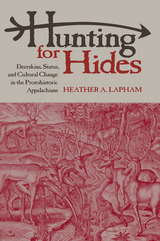
Hunting for Hides
Deerskins, Status, and Cultural Change in the Protohistoric Appalachians
Heather A. Lapham
University of Alabama Press, 2006
Changes in Native American communities as they adapted to advancing Europeans.
This volume investigates the use of deer, deerskins, and nonlocal goods in the period from A.D. 1400 to 1700 to gain a comprehensive understanding of historic-era cultural changes taking place within Native American communities in the southern Appalachian Highlands. In the 1600s, hunting deer to obtain hides for commercial trade evolved into a substantial economic enterprise for many Native Americans in the Middle Atlantic and Southeast. An overseas market demand for animal hides and furs imported from the Americas, combined with the desire of infant New World colonies to find profitable export commodities, provided a new market for processed deerskins as well as new sources of valued nonlocal goods. This new trade in deerskins created a reorganization of the priorities of native hunters that initiated changes in native trade networks, political alliances, gender relations, and cultural belief systems.
Through research on faunal remains and mortuary assemblages, Lapham tracks both the products Native Americans produced for colonial trade--deerskins and other furs--as well as those items received in exchange--European and native prestige goods that end up in burial contexts. Zooarchaeological analyses provide insights into subsistence practices, deer-hunting strategies, and deer-hide production activities, while an examination of mortuary practices contributes information on the use of the nonlocal goods acquired through trade in deerskins. This study reveals changes in economic organization and mortuary practices that provide new insights into how participation in the colonial deerskin trade initially altered Native American social relations and political systems.
[more]

Rethinking the 1898 Reform Period
Political and Cultural Change in Late Qing China
Rebecca E. Karl
Harvard University Press, 2002
The nine essays in this volume reexamine the “hundred days” in 1898 and focus particularly on the aftermath of this reform movement. Their collective goal is to rethink the reforms not as a failed attempt at modernizing China but as a period in which many of the institutions that have since structured China began. Among the subjects covered are the reform movement, the reformers, newspapers, education, the urban environment, female literacy, the “new” woman, citizenship, and literature. All the contributors urge the view that modernity must be seen as a conceptual framework that shaped the Chinese experience of a global process, an experience through which new problems were raised and old problems rethought in creative, inventive, and contradictory ways.
[more]
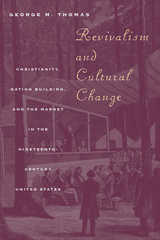
Revivalism and Cultural Change
Christianity, Nation Building, and the Market in the Nineteenth-Century United States
George M. Thomas
University of Chicago Press, 1989
The history of Christianity in America has been marked by recurring periods of religious revivals or awakenings. In this book, George M. Thomas addresses the economic and political context of evangelical revivalism and its historical linkages with economic expansion and Republicanism in the nineteenth century. Thomas argues that large-scale change results in social movements that articulate new organizations and definitions of individual, society, authority, and cosmos. Drawing on religious newspapers, party policies and agendas, and quantitative analyses of voting patterns and census data, he claims that revivalism in this period framed the rules and identities of the expanding market economy and the national policy.
"Subtle and complex. . . . Fascinating."—Randolph Roth, Pennsylvania History
"[Revivalism and Cultural Change] should be read with interest by those interested in religious movements as well as the connections among religion, economics, and politics."—Charles L. Harper, Contemporary Sociology
"Readers old and new stand to gain much from Thomas's sophisticated study of the macrosociology of religion in the United States during the nineteenth century. . . . He has given the sociology of religion its best quantitative study of revivalism since the close of the 1970s."—Journal for the Scientific Study of Religion
"Subtle and complex. . . . Fascinating."—Randolph Roth, Pennsylvania History
"[Revivalism and Cultural Change] should be read with interest by those interested in religious movements as well as the connections among religion, economics, and politics."—Charles L. Harper, Contemporary Sociology
"Readers old and new stand to gain much from Thomas's sophisticated study of the macrosociology of religion in the United States during the nineteenth century. . . . He has given the sociology of religion its best quantitative study of revivalism since the close of the 1970s."—Journal for the Scientific Study of Religion
[more]
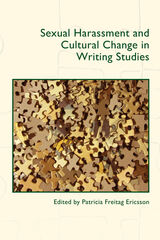
Sexual Harassment and Cultural Change in Writing Studies
Patricia Freitag Ericsson
University Press of Colorado, 2020
This collective project provides vital groundwork for understanding sexual harassment as well as encouraging the difficult conversations that are steps to awareness, action, and prevention. The project mandates a heightened consciousness of sexual harassment in American culture and underscores the profound commitment to cultural change necessary to eradicate this toxic social issue. Focusing on writing studies but applicable to other areas of higher education, the authors provide history, definitional backgrounds, best-practice approaches to prevention, scenarios for anti-sexual harassment training, and an extensive bibliography. The contributors have created a dynamic resource for a wide variety of audiences, including those who are leading programs, training new faculty and graduate students, preparing peer tutors, designing workshops, and teaching both undergraduate and graduate classes. This book can be used to start conversations, construct training, and improve policy—all of these in the contexts of local situations and constraints.
[more]
READERS
Browse our collection.
PUBLISHERS
See BiblioVault's publisher services.
STUDENT SERVICES
Files for college accessibility offices.
UChicago Accessibility Resources
home | accessibility | search | about | contact us
BiblioVault ® 2001 - 2024
The University of Chicago Press



